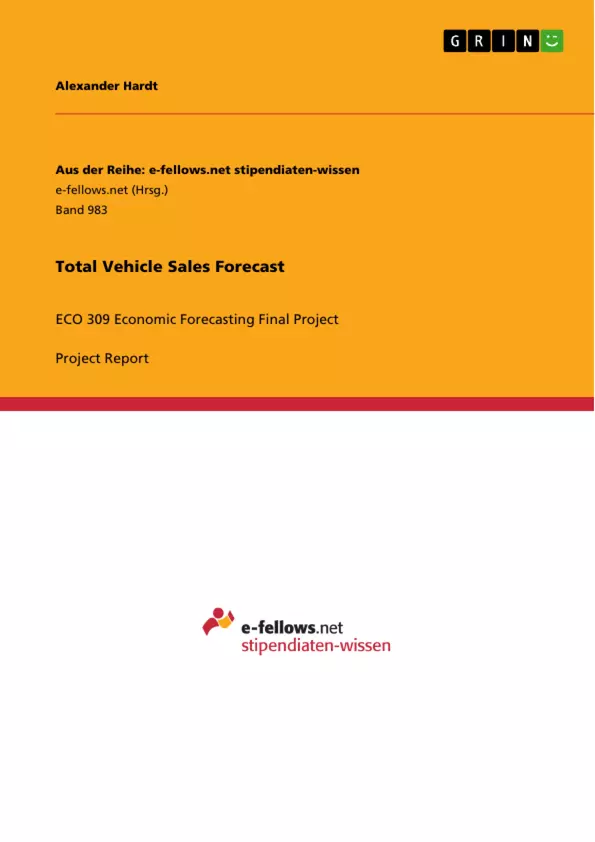For this project I created a twelve month forecast for Total Vehicle Sales in the United States using four different methods. These four techniques are called exponential smoothing, decomposition, ARIMA, and multiple regression. To do so I picked one dependent (Y) variable along with two independent (X) variables and collected 80 monthly observations for each variable. This historical data allowed me to create four different forecasting models which predict future Vehicle Sales with low risk of error. The best model according to the lowest error measures was winter’s exponential smoothing method because it had the lowest MAPE along with the lowest RMSE for the fit period as well as the forecast period.
Inhaltsverzeichnis (Table of Contents)
- Executive Summary
- Introduction
- Descriptive Statistics
- Time Series Plots
- Scatter Plots
Zielsetzung und Themenschwerpunkte (Objectives and Key Themes)
The primary objective of this project is to create a twelve-month forecast for Total Vehicle Sales in the United States using four different forecasting methods: exponential smoothing, decomposition, ARIMA, and multiple regression. The project aims to identify the most accurate forecasting model based on error measures.
- Analyzing the relationship between Total Vehicle Sales and economic indicators.
- Developing and comparing multiple forecasting models for Total Vehicle Sales.
- Evaluating the accuracy of forecasting models using error measures.
- Identifying the most effective forecasting method for Total Vehicle Sales.
- Exploring the impact of economic variables on vehicle sales trends.
Zusammenfassung der Kapitel (Chapter Summaries)
- Executive Summary: This section provides a concise overview of the project, outlining the forecasting methods used and the primary findings. It highlights the most accurate forecasting model based on error measures.
- Introduction: This section introduces the project's context, explaining the choice of Total Vehicle Sales as the dependent variable and the rationale for selecting Employment non-farm and Personal Saving Rate as independent variables. It also presents the hypotheses about the relationship between these variables.
- Descriptive Statistics: This section presents descriptive statistics for the variables used in the forecast, including mean, standard deviation, range, and quartiles. It analyzes the data characteristics to assess the potential for accurate forecasting.
- Time Series Plots: This section presents time series plots for Total Vehicle Sales, Employees non-farm, and Personal Saving Rate. It analyzes the trends, seasonality, and cyclical patterns observed in the data.
- Scatter Plots: This section presents scatter plots illustrating the relationship between the independent variables (Employees non-farm and Personal Saving Rate) and the dependent variable (Total Vehicle Sales). It analyzes the strength and nature of the linear relationships observed.
Schlüsselwörter (Keywords)
The primary keywords and focus topics of this project include Total Vehicle Sales, economic forecasting, exponential smoothing, decomposition, ARIMA, multiple regression, error measures, Employment non-farm, Personal Saving Rate, and time series analysis.
- Citar trabajo
- Alexander Hardt (Autor), 2013, Total Vehicle Sales Forecast, Múnich, GRIN Verlag, https://www.grin.com/document/279609



